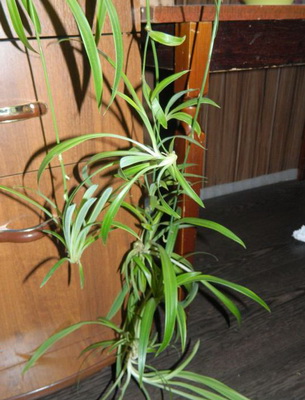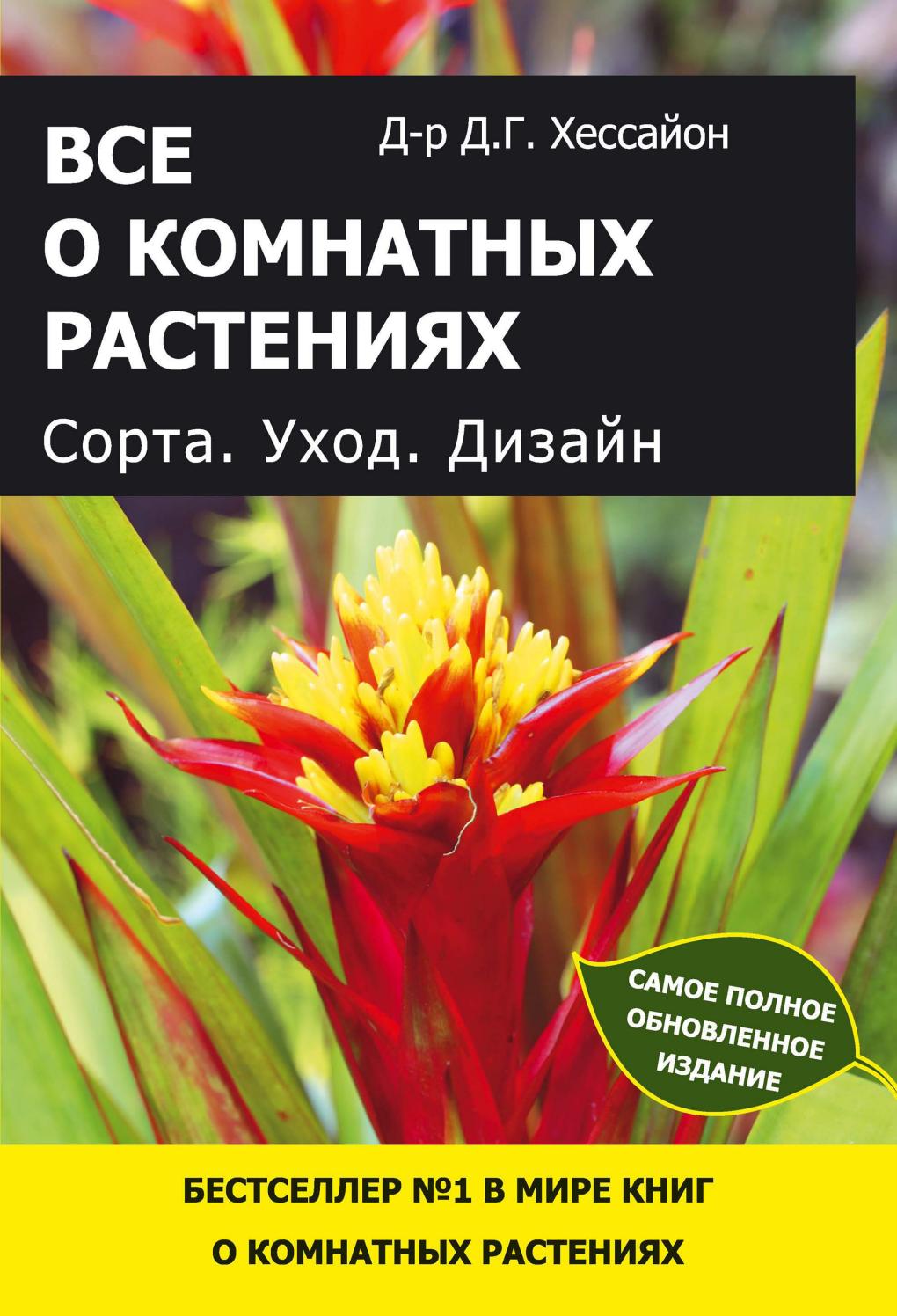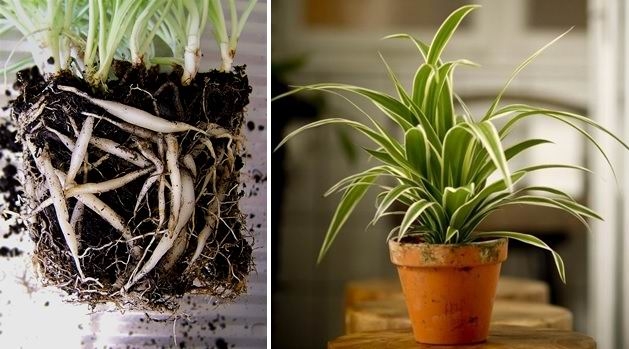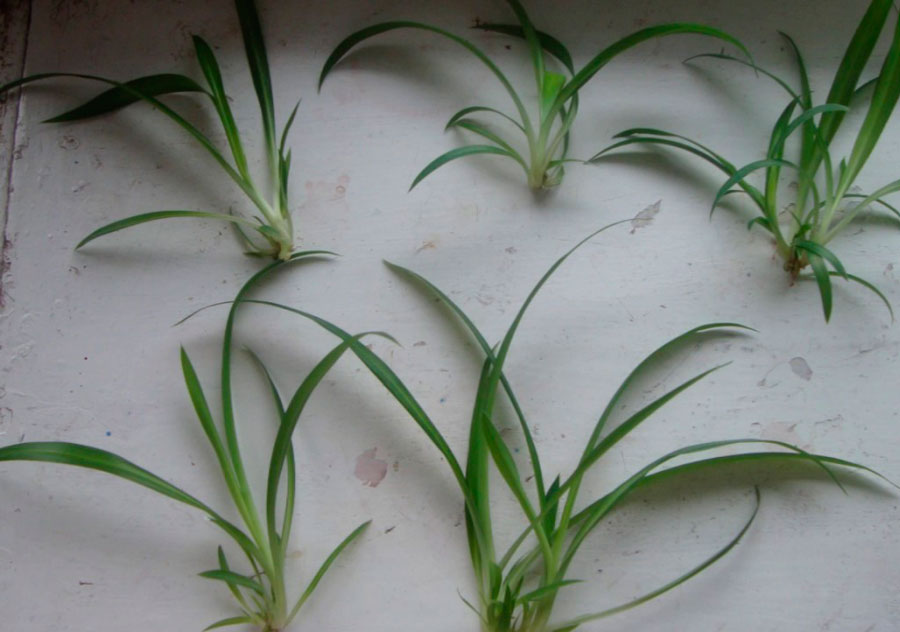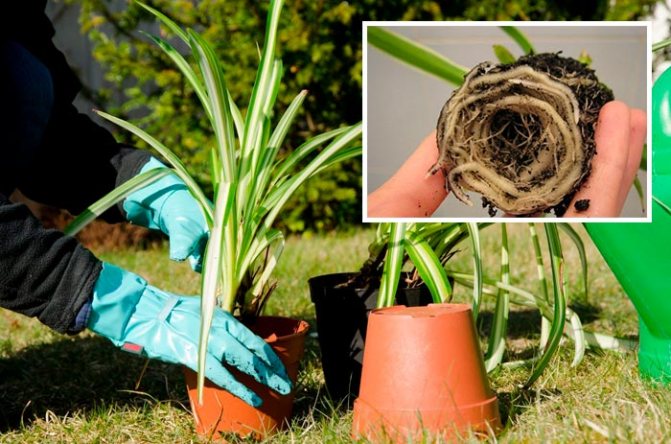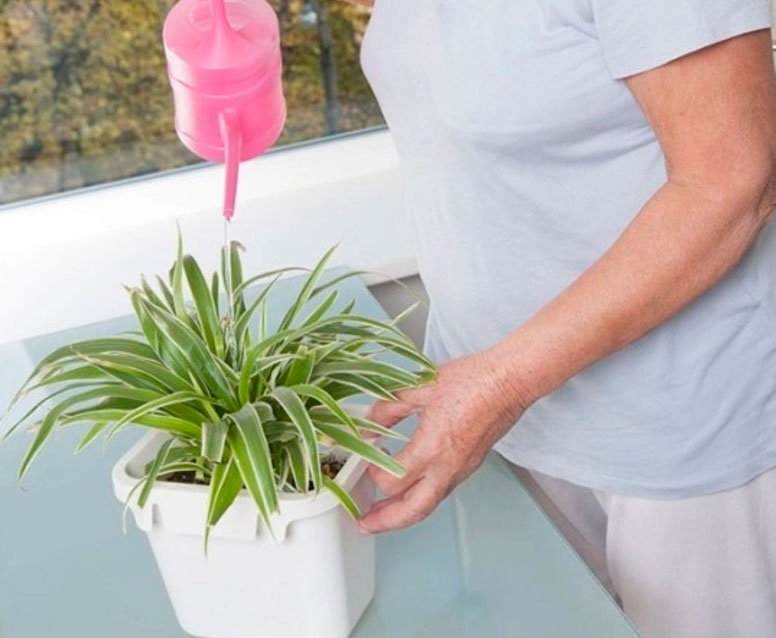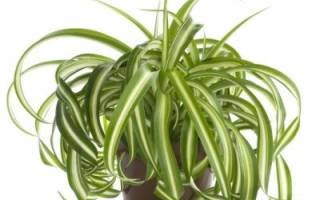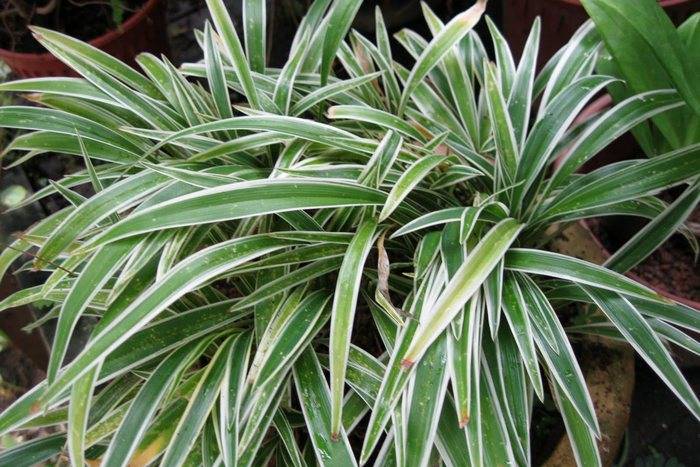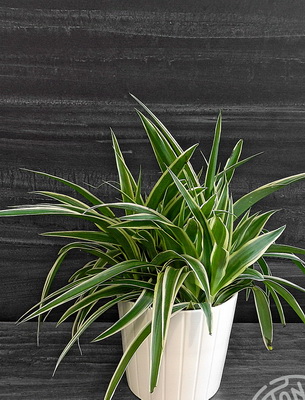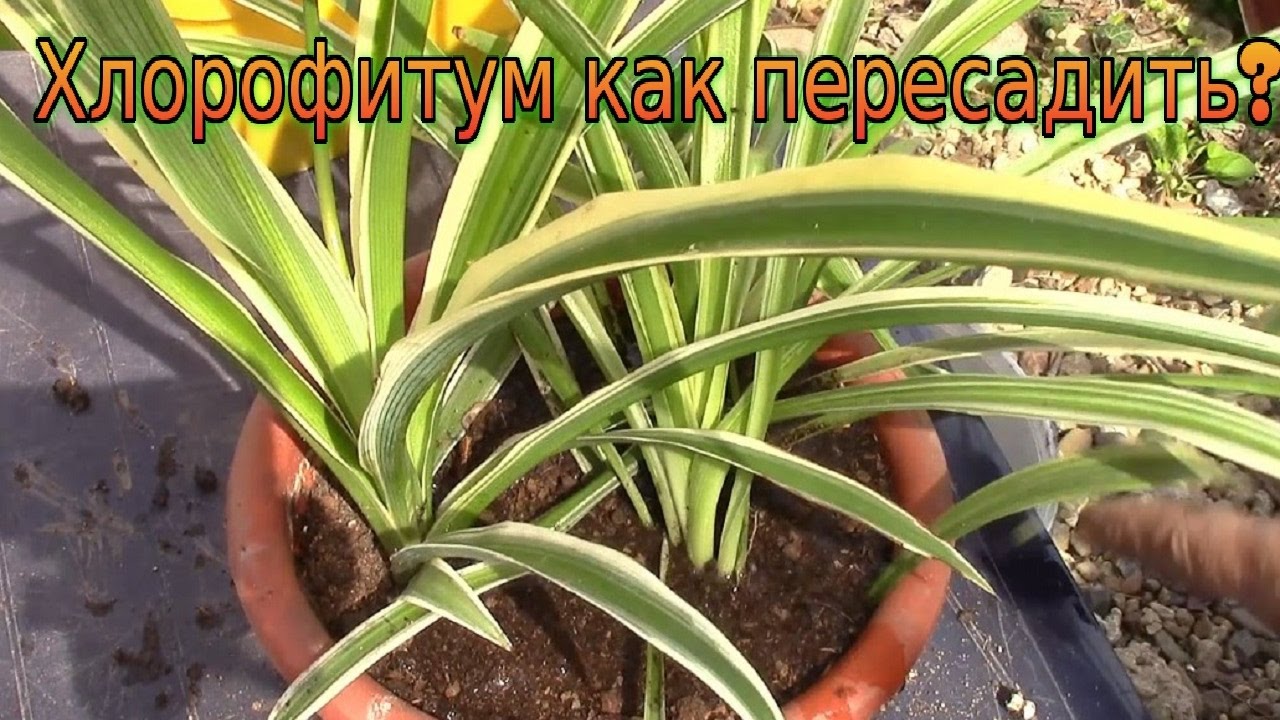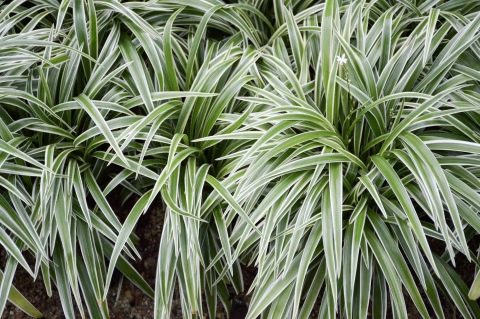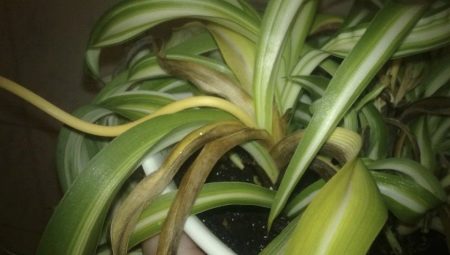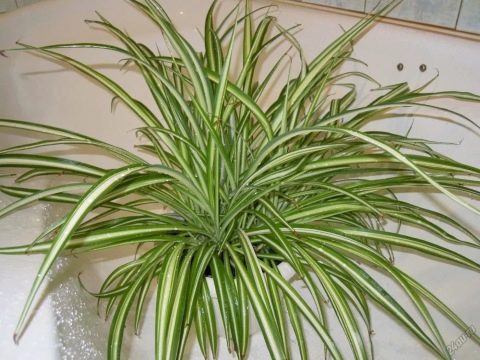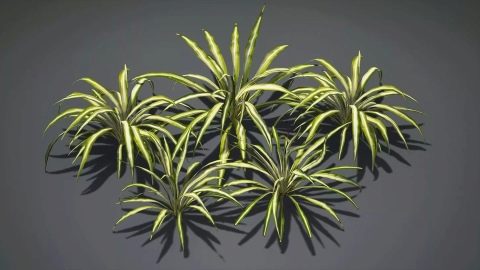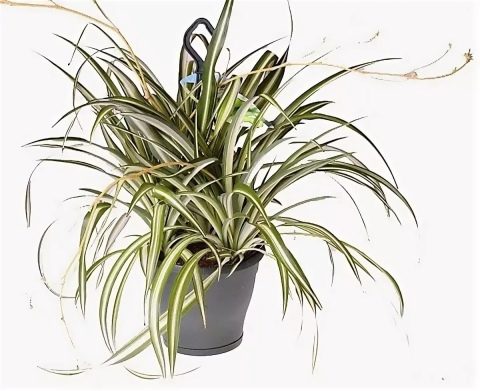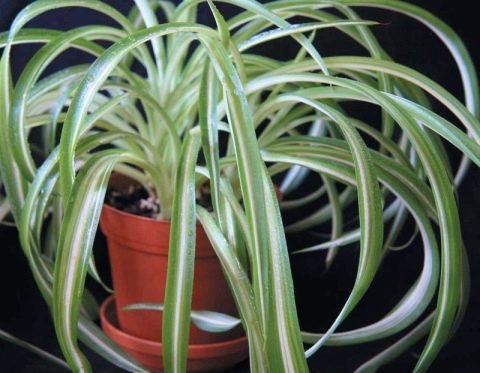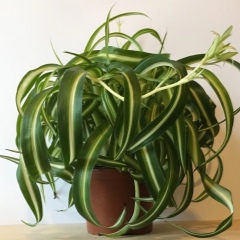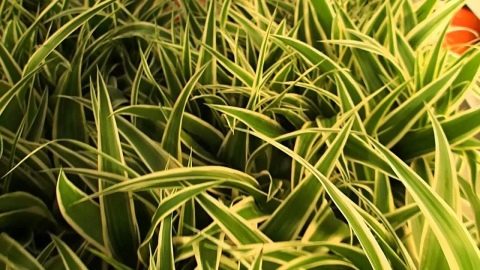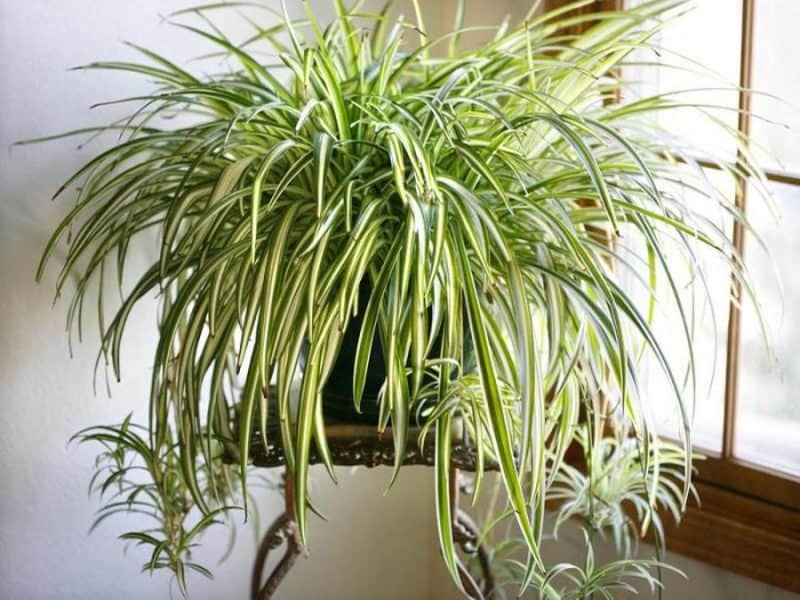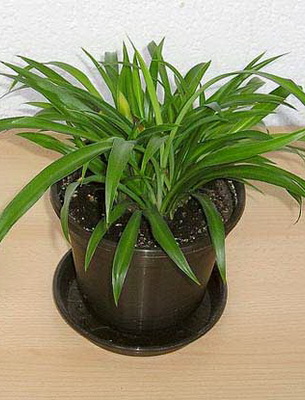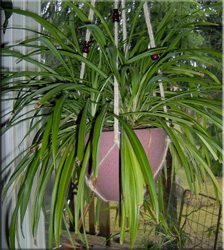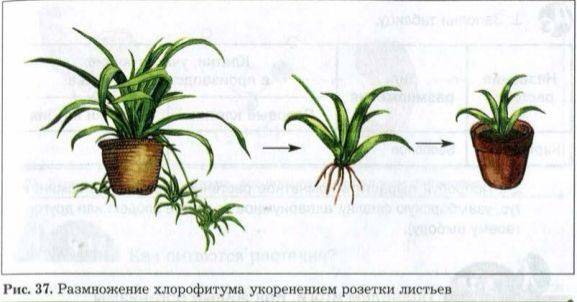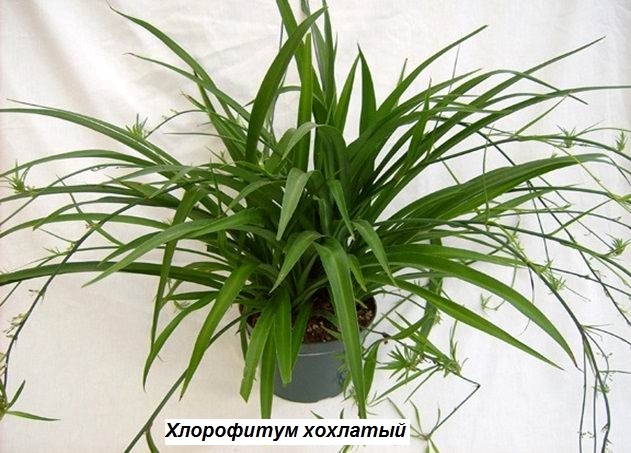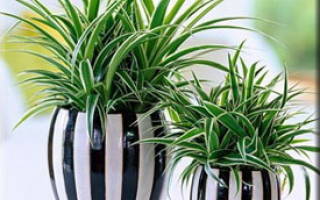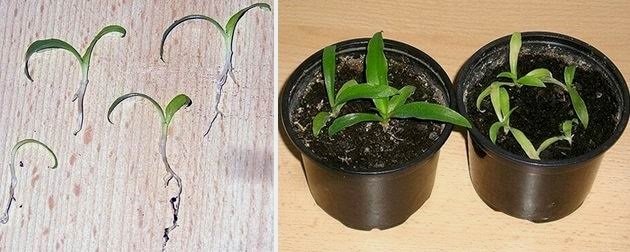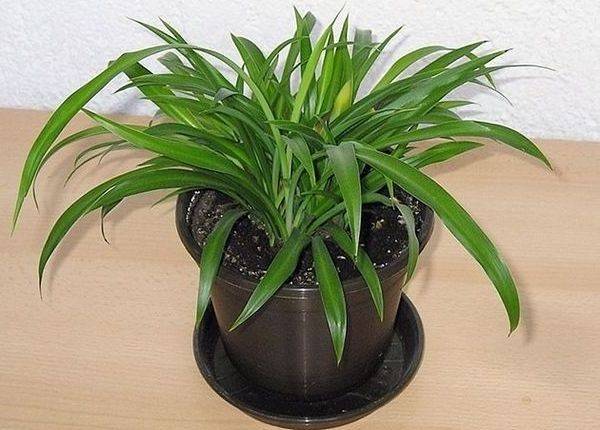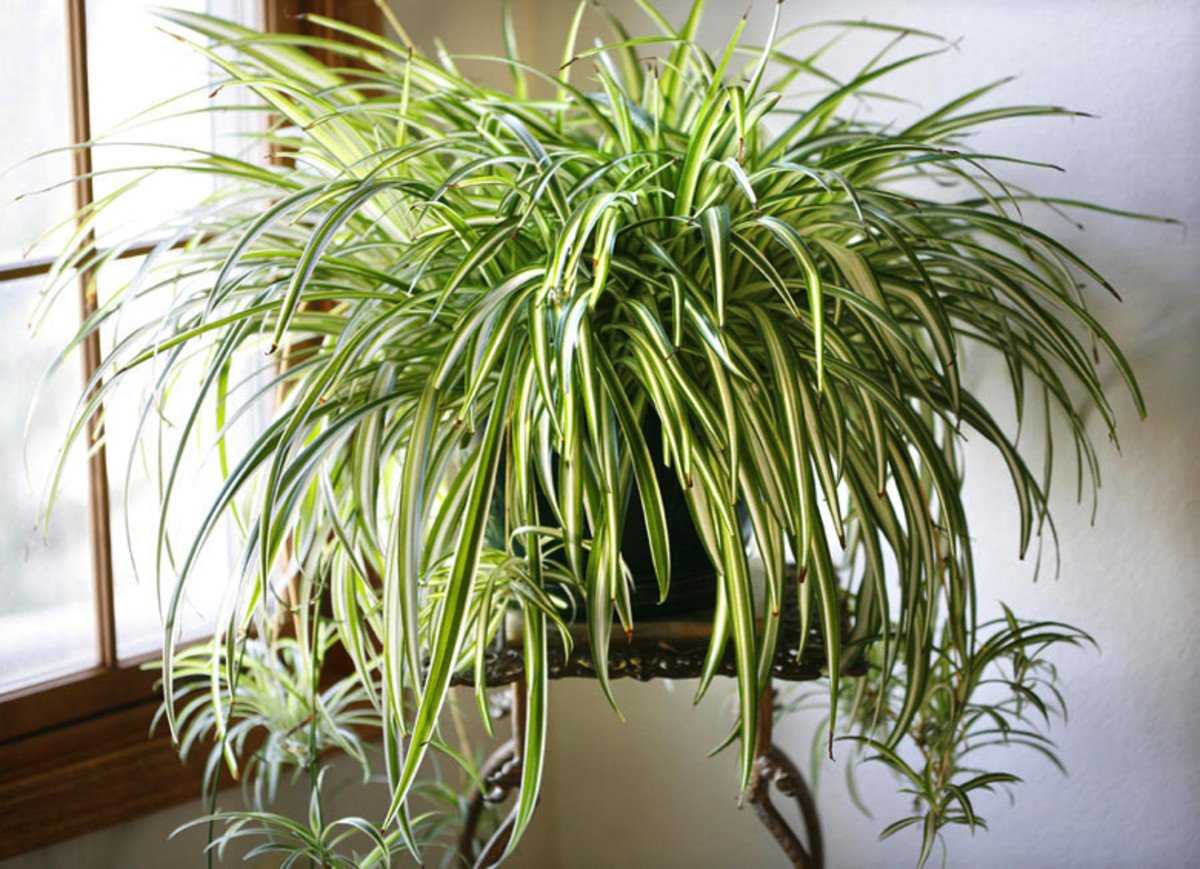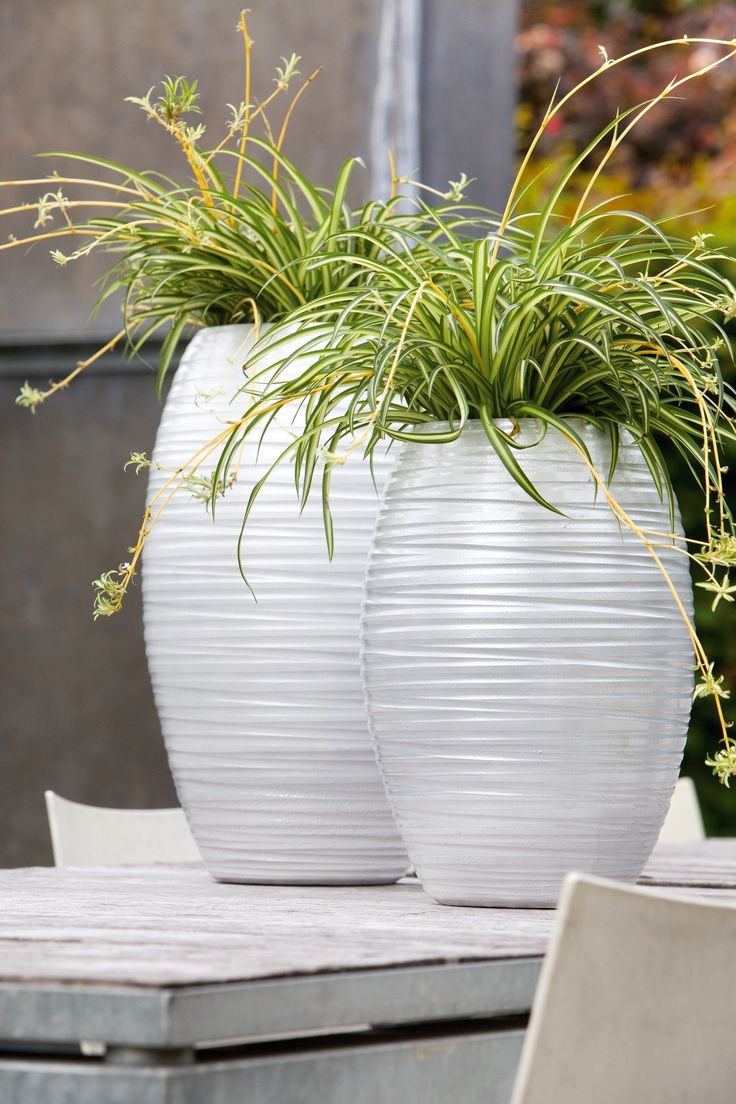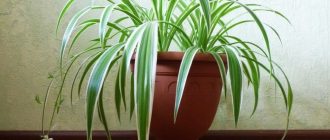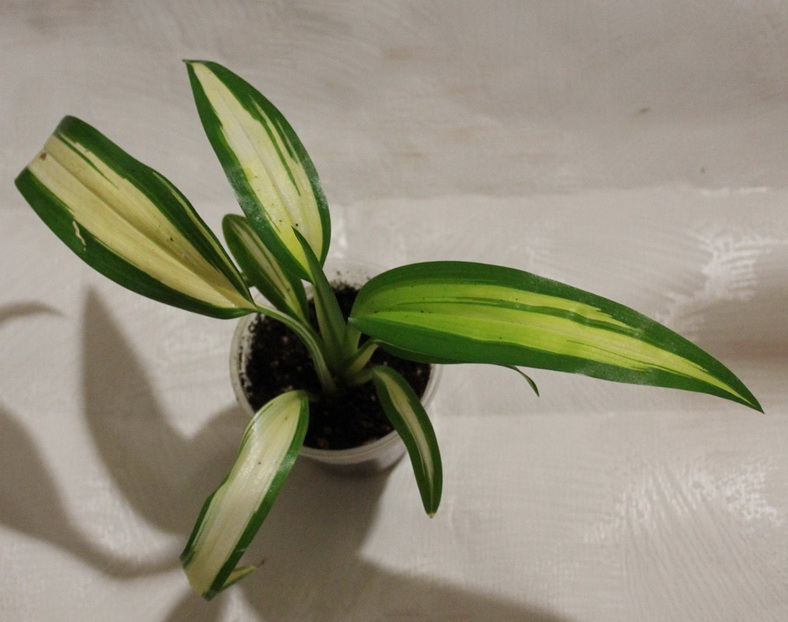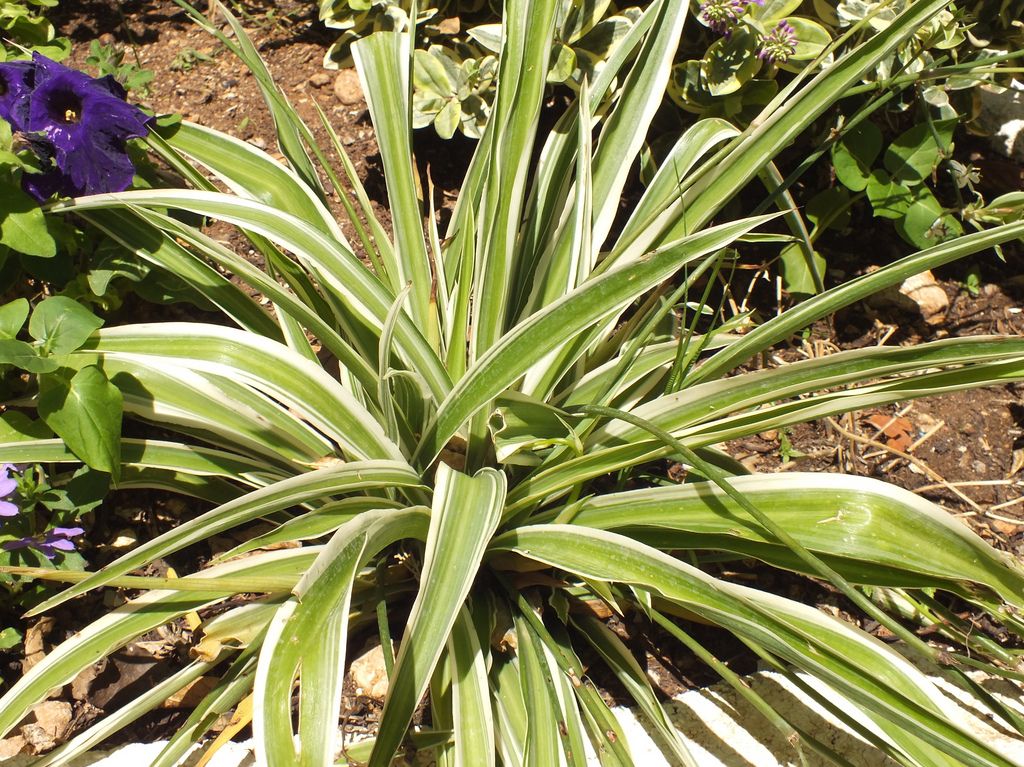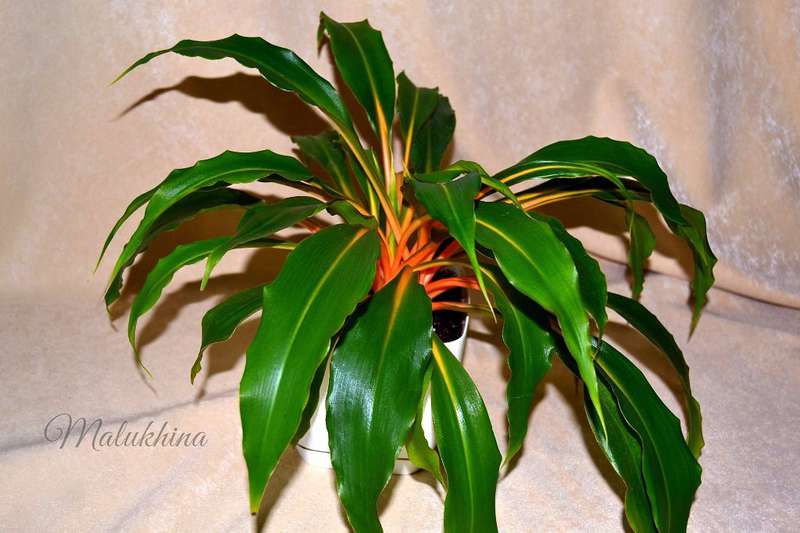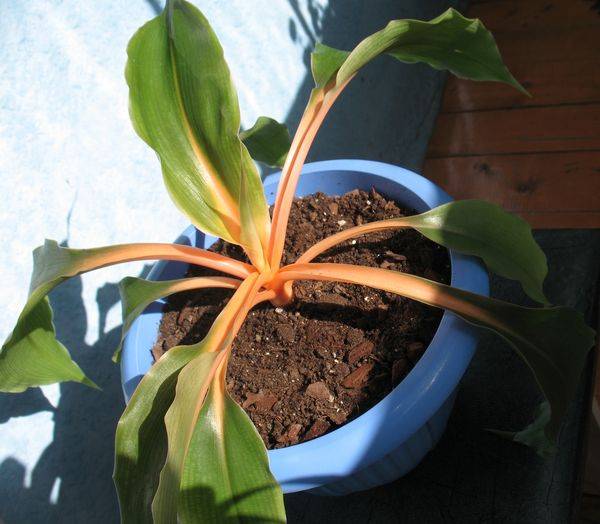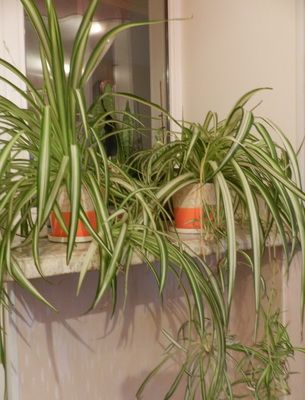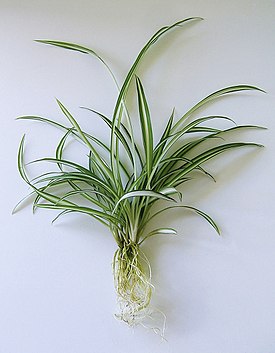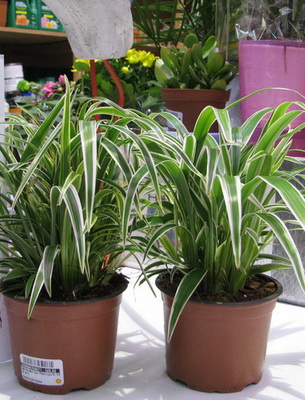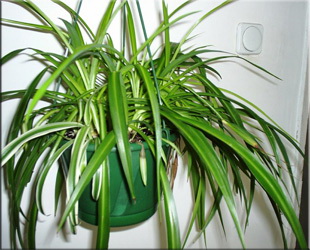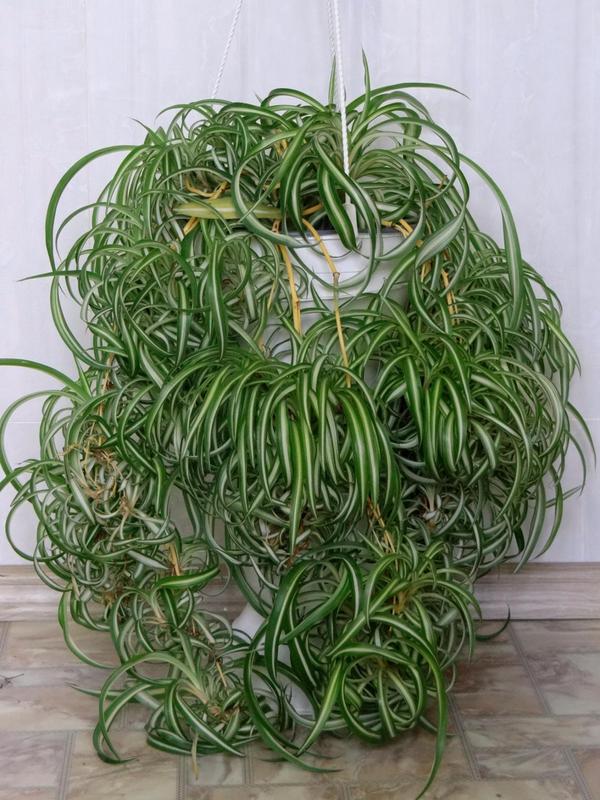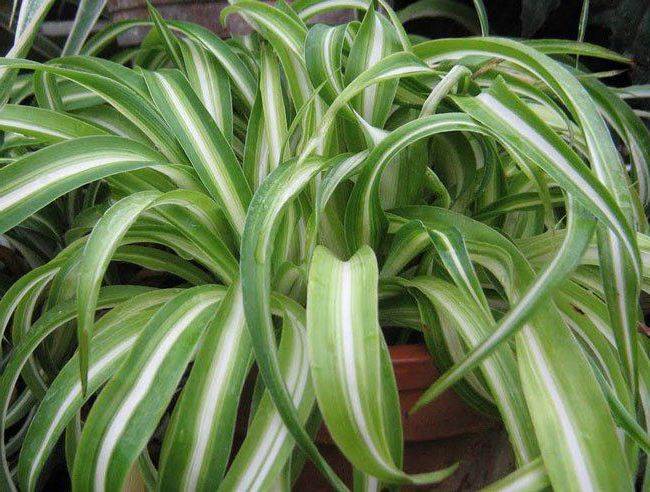What does simple chlorophytum look like?
It is necessary to understand exactly what a simple chlorophytum looks like. It is believed that all other varieties and varieties came from him. Let's take a closer look at the appearance of this plant.
Appearance
It is a herbaceous evergreen plant with a large number of subspecies. Given their diversity, it is not always possible to identify a culture.

Here are the main features:
- the stem is shortened. A large number of leaves grow from it;
- the bush itself is small. Usually no more than 60 cm in diameter with about the same in height;
- leaves are evergreen, elongated, reduced type;
- there may be small white flowers in the form of asterisks;
- after flowering, numerous daughter plants are formed, each of which has its own root system.
Reference. Today there is one- and two-tiered chlorophytum. It is very rare in nature to find a third tier. However, for a small stem, it is very difficult to hold it. There are bushy and woody varieties. The latter have a thick stem, which can be up to five tiers at a time.
Blooming chlorophytum with photo
This plant can bloom quite profusely. But this requires the achievement of ideal conditions. If they do not meet the requirements, then the bush remains evergreen.

For flowering, you must ensure the following:
- timely watering;
- correct transplant;
- top dressing;
- temperature regime;
- air humidity.
Under favorable conditions, several flowers appear on the plant. After that, new plants are obtained from them. Thus, Chlorophytum multiplies through flowering. If the conditions are not optimal, then it will grow without giving offspring. But this does not mean that you cannot get another plant. More details on breeding methods will be written below.
Description of the building
Briefly describing this culture, we can define the following:
- leaves are collected in an outlet;
- shortened stem;
- type of sheet attachment - sedentary;
- the shape of the plate is linear, the upper part is pointed or retracted;
- leaf is simple, without branches, with parallel venation, whole-edged.
Important! This description is only suitable for Chlorophytum vulgaris. Other varieties may differ significantly from him in appearance.
Root system
This plant grows rather quickly thanks to its developed root system. It differs in the following:
- yellowish color;
- branched roots;
- take up the entire pot rather quickly.

The roots absorb well the nutrients that are in the soil. Since they grow quickly, it is required to transplant the plant in a timely manner. Otherwise, the pot may burst. At the same time, it is also recommended to regularly feed. This will accelerate growth and increase flowering.
Chlorophytum types
Of the more than two hundred known types of chlorophytum, there are more popular and less demanded ones among those grown in culture. Let's get acquainted with the species that attract both professional flower growers and indoor plant lovers.
Chlorophytum crested (Chlorophytum comosum)
This is a perennial plant with a lush rosette of leaves - long, xiphoid, green in color with light longitudinal stripes. The flowers are small, white, in the place where they fade, children of the crested chlorophytum are formed, and this looks like a cascade of small rosettes around the adult chlorophytum. There is a variety of chlorophytum crested vittatum with a longitudinal light stripe in the middle of the leaf, maculatum with longitudinal yellow stripes, as well as the variety "Curty Locks" with striped leaves twisted into a wide spiral.
In the photo: Chlorophytum crested (Chlorophytum comosum)
Curly chlorophytum (Chlorophytum comosum)
Or chlorophytum Bonnie - a species similar to chlorophytum crested, but its leaves do not hang down, but curl. In addition, it is more compact than the crested. He has a white stripe along the leaves along the central vein.
In the photo: Bonny Chlorophytum (Chlorophytum comosum)
Cape Chlorophytum (Chlorophytum capense)
A type of chlorophytum without stripes on light green, linear, narrow-lanceolate leaves up to 60 cm long and up to 3 cm wide, which simply grow from a basal rosette. The peduncles of this species are short, the flowers are unattractive, and this chlorophytum does not form daughter rosettes, and it is most often propagated by dividing the bush.
In the photo: Cape Chlorophytum (Chlorophytum capense)
Winged chlorophytum (Chlorophytum amaniense)
He is orange chlorophytum, he is orchidostellar. This is a type of low chlorophytum (30-40 cm in height) with dark green leaves on long pink-orange petioles - very beautiful. The flower stalk of this chlorophytum is short, and when the seeds ripen, it looks like an ear of corn. In varieties such as Green Orange and Faye Flash, the contrast between the dark green color of the leaves and the bright orange petioles is very impressive.
In the photo: winged chlorophytum (Chlorophytum amaniense)
Chlorophytum Laxum
It is not often found on our windowsills. Its leaves are thin, and white stripes, unlike other types of chlorophytum, do not pass along the central vein, but along the edges of the green leaf. The leaves are collected in a root rosette. It blooms with small spike-shaped inflorescences. Does not form daughter outlets.
Chlorophytum crested Hoya (Hoya) - care, photos, types
After this article, they usually read
Add a comment
Chlorophytum diseases and pests
A life-loving flower rarely gets sick, nature is protected from parasites, but sometimes this happens. Consider how to care for a chlorophytum plant, its pests and diseases.
The most popular pests include:
- shield;
- spider mite;
- aphids;
- mealybug.
Parasites rarely settle on healthy and strong plants, but if the flower loses its vitality a little, they attack delicate leaves and roots.
Treatment - washing the flower with soapy water. The composition is prepared from half a piece of ordinary laundry soap, grated, and 5 liters of boiling water. The shavings are stirred until completely dissolved, the water is cooled and the plant is washed in the bathroom, covering the soil with a film.
Scabbard, spider mite are afraid of alcohol. They are removed with a swab soaked in vodka. Then they make a warm water shower for chlorophytum - they pour it from a watering can, covering the soil with a film.
The list of diseases is wide, but the symptoms are the same - the problem with leaves:
- Rot of the socket. The reasons are heavy soil, stagnant water. Treatment - remove the rosette along with the root, transplant the healthy part into light soil, remove water from the pan after watering.
- Poor coloring. Signs are especially noticeable on leaves with different shades of greenery. The reason is little light. Variegated varieties of exotic plants suffer from this. Treatment - once a day, the pot is transferred to a lighted windowsill or a phytolamp is placed.
- The appearance of brown and black spots on the leaves. The reason is excess watering, stagnant water. Treatment - reduce the volume of water, increase the time between procedures. Affected leaves are pruned at the point of growth.
- Change in turgor, color of green mass. The reason is too hot. Treatment is to ventilate the room.
- The lower leaves dry out. Under natural conditions, the plant periodically sheds its foliage. This is normal, the fallen greens are removed without allowing them to rot.
- The green mass wilted sharply, became limp. The reason is cold. At temperatures below +10 C, the flower freezes. Treatment - the pot is moved to a warm room, watered with warm, settled water.
The most common disease is yellowing of green mass. There are several reasons for this:
- depleted soil, which is fed with liquid fertilizers (mullein, mineral complex);
- excess dry air;
- too hot - the plant is taken out to a cool area;
- mechanical damage;
- the leaves turn yellow from the tightness of the pot - chlorophytum is transplanted into a spacious container;
- insufficient watering;
- dry, the tips of the leaves turn yellow - long breaks between waterings, hard water.
Many growers are concerned about the lack of flowers. And there are several reasons for this too:
- The plant is still too young. Peduncles appear only 1.5-2 years after germination.
- Large pot. Until the root system of chlorophytum has mastered 80% of the volume of the soil, there will be no flowers. They do not planted immediately in a large pot so that the roots do not rot due to excess moisture. For a one-year-old sprout, 0.5 liters is enough. Another 200-300 ml is added every year. At the age of 4-5 years, the culture is seated, separate flowerpots are allocated to the outlets.
- Small pot. Notice the lack of space on the protruding roots. In this case, they are transplanted into a large container. After mastering the soil, chlorophytum will bloom.
Possible problems in growing chlorophytums
Problems and illnesses arise from improper care or lack of it. The plant is resistant to various diseases and pests, but mistakes in cultivation and negligence of the owner of the flower can worsen its condition. If the necessary measures for treatment are not taken in time, the plant may die.
Often problems arise due to the characteristics of the variety, and sometimes, on the contrary, the variety has advantages in its cultivation. For example, when caring for chlorophytum curly at home, flower growers do not face the problem of pests. The fact is that the flower has a high antibacterial property, which scares away parasites.
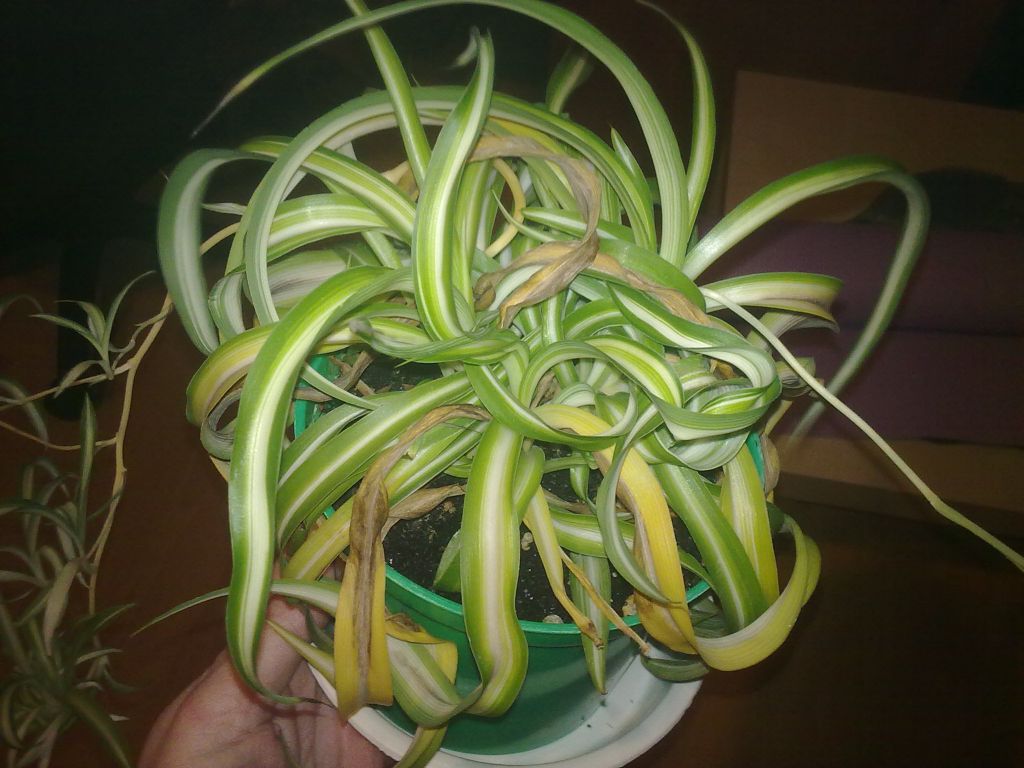
Yellowing of the tips of the leaves
Dry tips of chlorophytum leaves
Florists often wonder why the tips of the leaves begin to dry in chlorophytum. But not everyone notices that before drying, the plant shows that it is sick. At first, it begins to weaken, has a sluggish and unhealthy appearance, its growth slows down. Then the tips of the leaves begin to turn yellow.
Causes of yellowing of chlorophytum leaves:
- normal soil without fertilizers was used for planting. As a result, the plant lacks nutrients for healthy growth. It is necessary to feed with complex fertilizers, the purpose of which is to saturate the soil with the necessary mineral and organic substances. In the spring, it is imperative to transplant the flower into a nutritious substrate. The drug is applied according to the instructions and the recommended dose prescribed on the package;
- increased dryness in the room where the flower is grown. Frequent airing of the room is necessary without allowing a cold draft. To increase the humidity, the number of watering, spraying increases, and a container of water is placed next to the plant;
- the room temperature is increased. They struggle with the problem, as well as with dry air. On hot days, the plant must be placed in a dark, cool place;
- mechanical damage. Perhaps due to carelessness, the flower was damaged when it was moved to another place or the root was damaged when loosening;
- lack of transplants. The root has grown and it is cramped in a small pot.

Flower leaves may turn black
Why do chlorophytum leaf tips turn black
Improper care of chlorophytum leads to another problem - blackening of the tips of the leaves. At first, the leaves are covered with brown spots and turn brown, then they begin to turn black. The main reason for this behavior of the flower is excessive moisture in the soil or lack of loosening, which causes stagnation of moisture in the soil. In winter, the watering of the flower should be stopped so that it can rest.
Note! The leaves also turn black due to hypothermia, so you need to rearrange it to a lighted and warm place. Growing healthy chlorophytum at home can be done with proper care
The plant, in addition to its beautiful decorative appearance, has useful properties and is appreciated among flower growers.The beautiful flower fights bacteria and germs in the air, making it an ideal indoor plant in a child's room
Growing healthy chlorophytum at home can be done with proper care. The plant, in addition to its beautiful decorative appearance, has useful properties and is appreciated among flower growers. The beautiful flower fights bacteria and germs in the air, making it an ideal indoor plant in a child's room.
When and how Chlorophytum blooms
The absence of flowers can be for two reasons:
- insufficient lighting;
- untimely transplant.
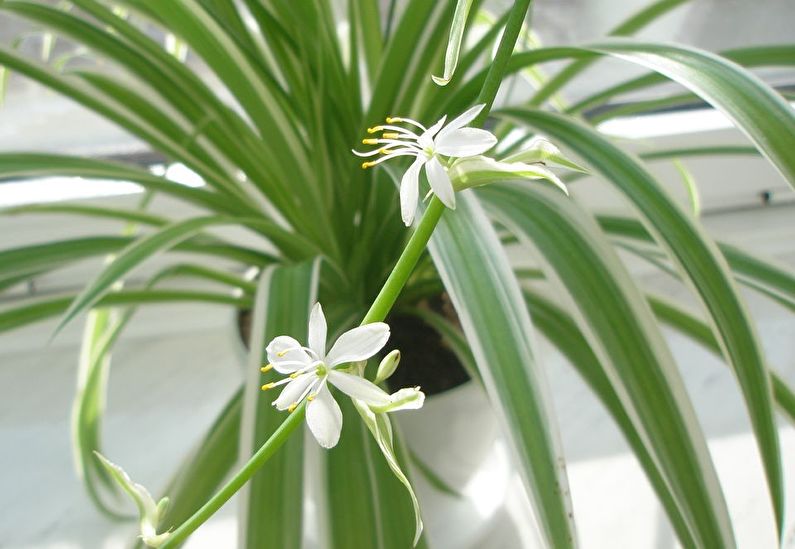
The vegetative period of the plant is active, very rarely, when the flower does not bloom for a long time
Repotting is necessary to renew the soil by transferring to a larger pot
During transplantation, it is important to examine the roots and remove all damaged ones, as they accumulate moisture, there is a high risk of rotting of the processes. Also, sometimes the tips of the leaves begin to turn black, which is also a sign of overflow of the plant.
Usually, after a spring transplant, two weeks later, the plant releases the first arrows of the peduncles. An indicator of a healthy plant will be the thickness and length of this shoot.
Note! If the plant feels comfortable, it releases flower arrows for the entire active period of growth - from spring to winter. Different varieties bloom differently, but they are all united by the unsightly flowers.
Chlorophytum is a deciduous ornamental plant that is not a beautifully flowering plant.
Different varieties bloom in different ways, but they are all united by the unsightly flowers. Chlorophytum is a deciduous ornamental plant that is not a beautifully flowering plant.
- Cape chlorophytum does not bloom at all at home. It reproduces by dividing the root and by babies that grow directly on the rosette of the flower.
- The striped and crested chlorophytums produce long shoots on which snow-white flowers with yellow stamens are arranged in a spiral. They are cute, but inconspicuous in comparison with the green fountain of lush greenery. After flowering, small bushes of children appear on the tips of the shoots of curly chlorophytum. They will soon acquire aerial roots and can live on maternal shoots for a long time. Crested varieties raise babies from leaf sinuses.
- Exotic and unusual varieties of chlorophytum, such as Orange, Laxum and Chlorophytum Ocean or Ocean, bloom with unusual ears of light yellow or greenish flowers.
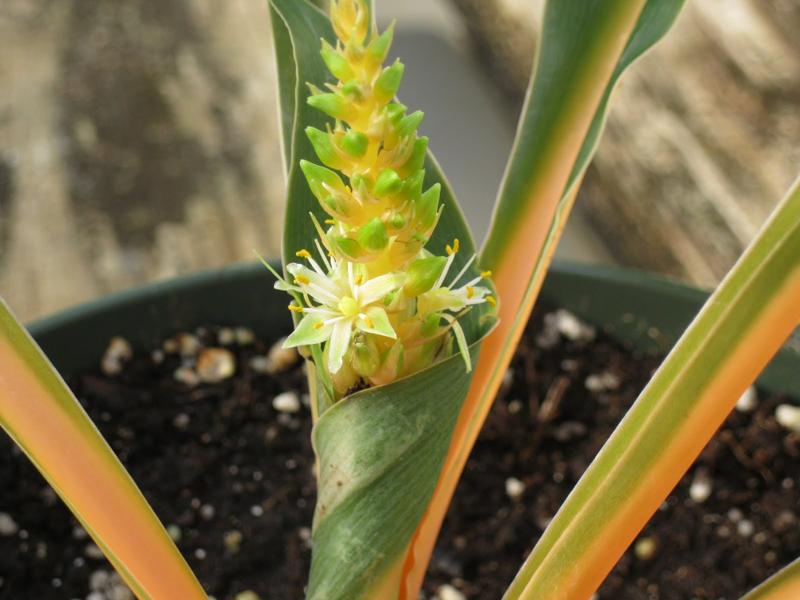
This interesting spikelet appears as if from a new leaf that envelops it until the end of flowering.
Chlorophytum is ideal for beginner growers and is loved by experienced breeders. Its unpretentiousness and decorativeness won the love of designers who use these green fountains in outdoor compositions. In the house, this phyto-friend will benefit from air purification and a minimum of hassle in leaving.
Who is chlorophytum: a short description
At home, the chlorophytum flower grows like an epiphyte. It settles on the branches of trees, and the aerial rhizome hangs down freely, getting food and moisture
Due to the numerous bulging tubers on the roots, in which water is stored, the plant is able to survive drought for a long time.
Chlorophytum belongs to herbaceous perennials and has the following characteristics:
- a long and narrow leaf blade, shaped like an arc;
- different colors of foliage or stripes on it;
- bush height from 35 to 100 cm;
- airy mustache with leaf rosettes ("kids") at the ends;
- flower cascade and the formation of leaf rosettes;
- white, small flowers in panicle inflorescence;
- the ability to form a powerful, tuberous rhizome.
This is not just a houseplant, but also a living filter that "works" as an air purifier
He has the ability to:
- protect from computer and magnetic radiation;
- humidify the air due to the release of excess moisture from the leaves;
- cleanse it of various toxins (harmful fumes, carbon monoxide, formaldehyde, tobacco smoke);
- enrich with phytoncides that destroy pathogenic bacteria.
The plant is not just decorative, it is useful. "Spider flower" absorbs carbon dioxide and impurities, saturating the atmosphere of the apartment with oxygen. For people with lung problems, allergy sufferers, this is a real find. For migraine sufferers - relief from painful conditions.
It is worth placing a pot of homemade chlorophytum in the kitchen, near the computer, in the recreation area, and it will "work" for you, creating a clean living environment and a favorable aura.
Among deciduous plants, it is a record holder air purification
Taxonomists are still arguing about the belonging of chlorophytums to a particular family. Some argue that these are representatives of the family. Liliaceae, but according to modern systematics they are referred to as this. Asparagus.
Anthurium (Anthurium): species and varieties, planting and care at home, reproduction, transplantation | (Photo & Video)
Conditions for the correct development of a flower
Optimum development will occur if the plant is provided with the best possible environmental conditions. If you follow all the recommendations, you will get a beautiful bush with beautiful leaves.
Follow these rules when growing chlorophytum.
| Aspect | Description |
|---|---|
| Light mode | Orange chlorophytum grows seamlessly in both sun and shade. However, if the shadow is too strong, then the culture will begin to stretch upward, and the petioles will lose their beautiful appearance and aesthetic value. The sun's rays should not burn the plant, their influence should not adversely affect. The plant loves the sun, but in the summer after lunch it is advisable to close the bush from the light. Chlorophytum can exist in partial shade, but in such a situation, its unusual color will fade. In summer, it is not advisable to remove the flower pot far away - he likes to be in the fresh air. If possible, you can put the flower in the shade of trees. |
| Temperature | As for the temperature regime, we can say that orange chlorophytum prefers warmth. The best temperature for good development is 25-27 degrees. In winter, the permissible temperature can be lowered to 20-22 degrees. In some situations, it is advisable to keep the plant at a temperature of 15 degrees Celsius, however, chlorophytum should not be in such conditions for a long time. A slight change in temperature will have a good effect on the bush, and a long stay in the cold will negatively affect immunity. |
| Location | The best location for the flower pot should be comfortable so that the plant can stay there for a long period without problems. Chlorophytum should not be placed on a windowsill where cold drafts are frequent. These conditions negatively affect him, provoke diseases. in the summer, it will be advisable to place the flower pot in the fresh air. For this purpose, a balcony or veranda is used. Fresh air accelerates the growth of chlorophytum, makes its characteristic color even brighter. |
| Humidity | Orange chlorophytum does not require high humidity; it is allowed to sometimes spray it with water in the summer. However, it is necessary to do this so that during the spraying process it is not in direct sunlight. This will cause sunburn on the foliage. |
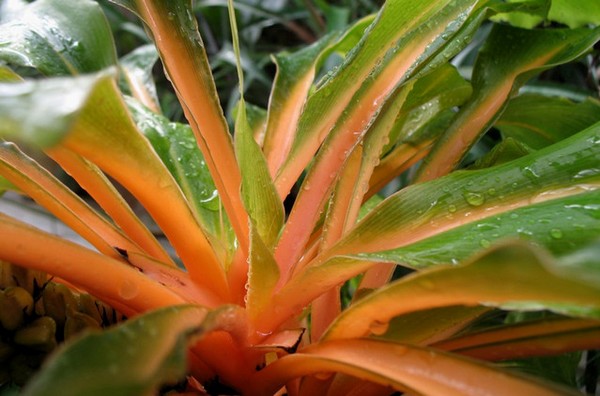
To grow a healthy flower, you will have to make some efforts to create conditions suitable for it.
It is very important to provide the plant with adequate lighting for its requirements. Orange chlorophytum needs control
The reason is that when a flower stays in direct sunlight for too long, its leaves will be burned and the color will become faded. Otherwise, a long shadow can affect the shade of the cutting or edging - they lose their characteristic orange color.
How to use chlorophytum in the interior of an apartment?
Often this culture is used to make an apartment more attractive.Also, the flower has many positive properties. It is worth considering in more detail all these nuances.
Home benefits
Chlorophytum is often grown at home by florists. Moreover, you can often find several species at once in one apartment. The variety allows you to create original interiors. When the kids are hanging from the main bush, it looks very beautiful. The same goes for crested chlorophytums. Orange is much less common.
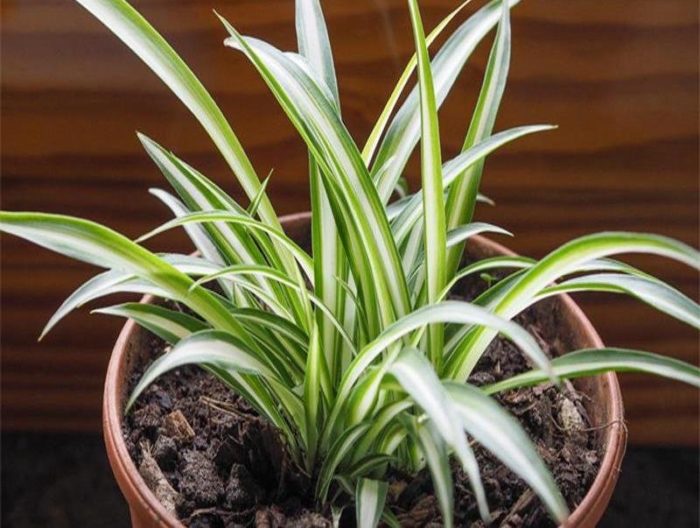
Regardless of the type of flower, it has many useful properties, the following can be attributed to them:
- Air purification from harmful impurities and toxins.
- The plant is quite beautiful and decorates the interior.
- Humidification of indoor air.
- Prevention of colds.
- Reducing the risk of developing allergies. If it is, then its negative impact is suppressed.
This flower is often bred not only because of its decorative qualities, but also because of its beneficial properties. However, it is worth putting it higher if there are small children in the apartment. The fact is that its juice is poisonous to humans: if a baby bites a leaf, it can be poisoned.
Today chlorophytum can be seen in many institutions and apartments. The plant is unpretentious. The number of species is amazing, new ones periodically appear. But this is already the result of the work of breeders. It is not difficult to propagate this culture, since after flowering a new flower always appears. Thus, this is a great opportunity to practice growing indoor flowers for aspiring florists.
Chlorophytums from A to Z: types
Chlorophytum crested - green aura and purity of air in our house
Of the 200 species of chlorophytum known in nature, only six grow at home. From this small number, many varieties have been created, differing in shape, size, location, color intensity of the leaf blade.
Crested or komosum (Chlorophytum somosum)
Chlorophytum somosum
Crested or komosum (Chlorophytum somosum)
The most common type and beautiful ampelous plant. The plant releases shoots up to a meter, on which flowers are formed, and then an airy mustache.
Different varieties have their own variations in color and edging. The most common variety is Variegata with white or yellow longitudinal stripes, various variegated forms, less often varieties with a monochromatic, green color.
Thanks to the unusual fountain of leaves and a small, delicate flower, the plant was dubbed "the lily of St. Bernard."
Curly (Chlorophytum comosum "Bonnie")
Twisted, curly leaves give the plant an unusual shape
Curly (Chlorophytum comosum "Bonnie")
Leaves 60 cm long form dense basal rosettes: many lanceolate leaves emerge from one stem. Their colors are bright green, with a white stripe in the center.
They are twisted into a kind of bundle from which peduncles appear. But after flowering "babies" are not formed, so you can grow daughter plants only by dividing the bush.
Cape (Chlorophytum capense)
Unassuming appearance is compensated by the rich color of the leaves
Cape (Chlorophytum capense)
It resembles curly chlorophytum with a longer, up to a meter, leaf blade without stripes. This large plant is suitable for lovers of large flower forms. Oblong, arched leaves of rich green color.
The species throws out a flower arrow, but does not form a leaf rosette. Propagated by dividing the bush.
Cape chlorophytum grows well not only in apartments, but also in the open air. It can be found on flower beds, balconies, terraces, where it endures summer temperature drops.
Green Orange (Chlorophytum Green orange)
The elegant orange color and shape of the leaves make it unlike close relatives.
Green Orange (Chlorophytum Green orange)
Elliptical shape leaves grow up to half a meter... A spectacular juicy orange petiole turns into dark green, glossy leaves. There is no stem, a rosette of bunches of leaves is formed at the base.
The view is compact, its height is 35 cm.During a short flowering, Orange looks fabulous. To maintain an elegant color, the plant is placed in diffused light, but not in the shade.
Winged or orange (Chlorophytum amaniense)
The ancestor of Green Orange is characterized by a rich color gamut
Winged or orange (Chlorophytum amaniense)
Another name - orchidostellar - is associated with wide leaves arranged in a circle on long petioles. The fleshy leaf petioles range in color from yellow to crimson (also called marmalade). Orange tones are more common, in which the core of the leaf is also painted.
He has several varieties - "Green Orange" and "Fire Flash", which delight with sunny shades. Due to the short peduncles, "babies" are formed at the base of the bush.
When flower rosettes are formed in the form of a spikelet with white flowers, the orange color of the petioles disappears. To preserve bright colors, the mustache is trimmed. But even with spiral peduncles, the plant does not lose its decorative effect.
Laxum (Chlorophytum laxum)
Chlorophytum laxum
Laxum (Chlorophytum laxum)
One of the rarest types of deciduous chlorophytums. Forms a dense root rosette of leaves. The narrow leaf plates are framed by a white edging, which gives the plant a sharper and more strict outline.
Forms a flowering shoot in the form of a spikelet, but does not form hanging rosettes of leaves. Reproduction is difficult due to the poor survival rate of daughter bushes.
Each species is distinguished by an abundance of varietals. Most of them are in the popular crested chlorophytum, which belongs to ampelous plants and is often grown in hanging pots.
Of the new products, you should pay attention to:
- Variegatum: white stripes are located at the edges of the leaf;
- Vittatum: a white streak running down the center of the leaf;
- Mboyeti: wavy leaf blade and dark emerald color;
- Atlantic: thin, wavy leaves;
- Ocean: short leaf bordered with white stripes;
- Maculatum: large leaf with yellow stripes;
- Curty Locks: A wide leaf with white and green stripes is rolled into a spiral.
A rare species that is whimsical to growing conditions
Dieffenbachia: description of 12 varieties for cultivation at home, features of care, transplantation and reproduction (Photo & Video) + Reviews

